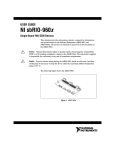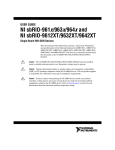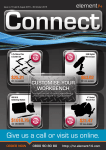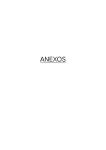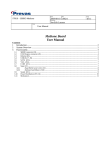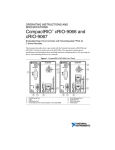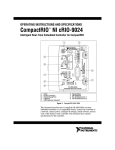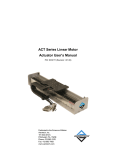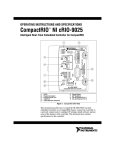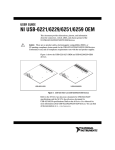Download NI sbRIO-9601/9602 and NI sbRIO-9602XT User Guide
Transcript
USER GUIDE NI sbRIO-9601/9602 and NI sbRIO-9602XT Single-Board RIO OEM Devices This document provides dimensions, pinouts, connectivity information, and specifications for the National Instruments sbRIO-9601, sbRIO-9602, and sbRIO-9602XT. The devices are referred to inclusively in this document as the NI sbRIO-9601/9602/9602XT. The NI sbRIO-9601/9602/9602XT must be installed inside a suitable enclosure prior to use. Hazardous voltages may be present. Caution National Instruments makes no product safety, electromagnetic compatibility (EMC), or CE marking compliance claims for NI sbRIO devices. The end-product supplier is responsible for conformity to any and all compliance requirements. Caution Exercise caution when placing the NI sbRIO device inside an enclosure. Auxiliary cooling may be necessary to keep the device under the maximum ambient temperature rating for the NI sbRIO device. Refer to Specifications section for more information about the maximum ambient temperature rating. Caution Figure 1 shows the NI sbRIO-9601/9602/9602XT. Figure 1. NI sbRIO-9601/9602/9602XT What You Need to Get Started This section lists the software and hardware you need to start programming the NI sbRIO device. Software Requirements You need a development computer with the following software installed on it. Go to ni.com/info and enter the Info Code rdsoftwareversion for information about software version compatibility. ❑ LabVIEW ❑ LabVIEW Real-Time Module ❑ LabVIEW FPGA Module ❑ NI-RIO Hardware Requirements You need the following hardware to use the NI sbRIO device. ❑ NI sbRIO-9601/9602/9602XT ❑ 19–30 VDC power supply ❑ Ethernet cable Dimensions This section contains dimensional drawings of the NI sbRIO devices. For three-dimensional models, refer to the Resources tab of the NI sbRIO product page at ni.com. The plated mounting holes are all connected to P1, the ground lug. Connect P1 or one of the plated mounting holes securely to earth ground. Refer to the Understanding Ground Connections section for cautions about current loops through the grounding lug. Note NI sbRIO-9601/9602/9602XT User Guide 2 ni.com 8.076 (205.13) 5.147 (130.72) 3.691 (93.75) 2.237 (56.81) Figure 2 shows the dimensions of the NI sbRIO-9601/9602/9602XT. 7X Ø 0.134 (3.4) 3.650 (92.71) 3.520 (89.41) 3.520 (89.41) 2.440 (61.98) 2 MM CLEARANCE REQUIRED ABOVE THIS CAPACITOR 0.550 (13.97) 0.275 (6.99) 0.140 (3.56) 0.450 (11.43) 8.200 (208.28) 7.295 (185.29) 4.100 (104.14) 0.810 (20.57) 0.000 (0) 0.775 (19.69) 0.000 (0) 2 MM CLEARANCE REQUIRED ABOVE THIS CAPACITOR 0.469 (11.91) –0.110 (2.79) MINIMUM CLEARANCE NEEDED BELOW BOARD 2X 4-40 THREADS 0.380 (9.65) 0.365 (9.28) 0.651 (16.54) 0.220 (5.59) 8.137 (206.68) 8.200 (208.28) 7.502 (190.55) 6.617 (168.06) 5.633 (143.07) 4.659 (118.33) 4.100 (104.14) 2.905 (73.79) 3.100 (78.74) 2.386 (60.61) 1.705 (43.31) 0.625 (15.88) 0.327 (8.31) 0.242 (6.16) 0.000(0) 0.180 (4.57) 0.080 (2.03) 0.000 (0) 7.911 (200.94) 8.200 (208.28) 6.927 (175.95) 5.001 (127.03) 4.017 (102.03) 2.091 (53.11) 0.940 (23.88) 1.107 (28.12) 0.000 (0) 0.286 (7.26) 0.327 (8.31) 0.080 (2.03) 0.000 (0) Figure 2. NI sbRIO-9601/9602/9602XT Dimensions in Inches (Millimeters) © National Instruments Corporation 3 NI sbRIO-9601/9602/9602XT User Guide 8.709 (221.21) 2.889 (73.38) 2.910 (73.91) 5.799 (147.29) 5.820 (147.83) You can install up to three board-only C Series I/O modules on the NI sbRIO device. The following figure shows the dimensions of the NI sbRIO-9601/9602/9602XT with three board-only C Series I/O modules installed. 6.565 (166.75) 5.515 (140.08) 4.265 (108.33) 3.965 (100.71) 3.650 (92.71) 8X Ø 0.125 (3.18) 2.885 (73.28) 2.514 (63.86) 2 MM CLEARANCE REQUIRED ABOVE THIS CAPACITOR Ø 0.512 (13) 1.212 (30.78) 8.200 (208.28) 6.442 (163.63) 3.340 (84.84) 0.000 (0) 0.285 (7.23) 0.000 (0) Figure 3. NI sbRIO-9601/9602/9602XT with C Series Modules, Dimensions in Inches (Millimeters) To maintain isolation clearances on the C Series modules, do not use mounting hardware larger than 0.240 in. (6.1 mm) in diameter and maintain an air gap of at least 0.200 in. (5.0 mm) from the modules to anything else. Note NI sbRIO-9601/9602/9602XT User Guide 4 ni.com I/O and Other Connectors on the NI sbRIO Device Figure 4 shows the locations of parts on the NI sbRIO device. 1 2 4 3 5 6 3 7 3 3 8 9 16 3 3 1 2 3 4 5 6 7 8 15 14 3 13 J11, Connector for C Series Module 3 P5, 3.3 V Digital I/O Plated Mounting Holes J10, Connector for C Series Module 2 P4, 3.3 V Digital I/O J9, Connector for C Series Module 1 DIP Switches Backup Battery 12 11 9 10 11 12 13 14 15 16 3 10 P2, 3.3 V Digital I/O J5, RJ-45 Ethernet Port J1, RS-232 Serial Port Reset Button P1, Ground Lug LEDs J3, Power Connector P3, 3.3 V Digital I/O Figure 4. NI sbRIO-9601/9602/9602XT Parts Locator Diagram © National Instruments Corporation 5 NI sbRIO-9601/9602/9602XT User Guide Table 1 lists and describes the connectors on NI sbRIO devices and the part number and manufacturer of each connector. Refer to the manufacturer for information about using and matching these connectors. Table 1. NI sbRIO Connector Descriptions Manufacturer and Part Number Recommended Mating Connector 2-position MINI-COMBICON header and plug, 0.285 in. (7.24 mm) high Phoenix Contact, 1727566 Sauro, CTF02BV8-BN (included) J1, RS-232 Serial Port 9-pin DSUB plug, 0.318 in. (8.08 mm) high, with 4-40 jacksockets Tyco Electronics, 5747840-6 — P2, P3, P4, P5 50-pin polarized header plug, 0.100 × 0.100 in. (2.54 × 2.54 mm) 3M, N2550-6002RB 3M, 8550-4500PL Connector Description J3, Power NI sbRIO-9601/9602/9602XT User Guide 6 ni.com The following figures show the pinouts of the I/O connectors on the NI sbRIO devices. Pin 50 Pin 1 D GND 50 49 Port2/DIO8 D GND 48 47 Port2/DIO7 D GND 46 45 Port2/DIO6 D GND 44 43 Port2/DIO5 D GND 42 41 Port2/DIO4 D GND 40 39 Port6/DIO8 D GND 38 37 Port6/DIO7 D GND 36 35 Port6/DIO6 D GND 34 33 Port6/DIO5 D GND 32 31 Port6/DIO4 D GND 30 29 Port6/DIO3 D GND 28 27 Port6/DIO2 D GND 26 25 Port6/DIO1 D GND 24 23 Port6/DIO0 Port6/DIOCTL 22 21 Port6/DIO9 D GND 20 19 Port5/DIO8 D GND 18 17 Port5/DIO7 D GND 16 15 Port5/DIO6 D GND 14 13 Port5/DIO5 D GND 12 11 Port5/DIO4 5V 10 9 Port5/DIO3 D GND 8 7 Port5/DIO2 5V 6 5 Port5/DIO1 Port5/DIO9 4 3 Port5/DIO0 Port5/DIOCTL 2 1 D GND Figure 5. Pinout of I/O Connector P2, 3.3 V Digital I/O © National Instruments Corporation 7 NI sbRIO-9601/9602/9602XT User Guide D GND 5V 50 49 48 47 Port9/DIO8 D GND 46 45 44 43 42 41 Port9/DIO6 40 39 38 37 Port9/DIO3 36 35 34 33 Port9/DIO1 32 31 Port9/DIO9 Port8/DIO8 D GND 30 29 28 27 26 25 D GND D GND D GND D GND 24 22 20 18 23 21 19 17 Port8/DIO5 D GND D GND Port8/DIOCTL 16 15 14 13 12 11 Port8/DIO1 D GND D GND D GND 10 8 6 4 9 7 5 3 Port7/DIO8 2 1 D GND 5V D GND Pin 50 D GND D GND D GND D GND Port9/DIOCTL Pin 1 D GND D GND D GND Port7/DIO4 Port9/DIO7 Port9/DIO5 Port9/DIO4 Port9/DIO2 Port9/DIO0 Port8/DIO7 Port8/DIO6 Port8/DIO4 Port8/DIO3 Port8/DIO2 Port8/DIO0 Port8/DIO9 Port7/DIO7 Port7/DIO6 Port7/DIO5 Figure 6. Pinout of I/O Connector P3, 3.3 V Digital I/O NI sbRIO-9601/9602/9602XT User Guide 8 ni.com D GND D GND 50 49 48 47 Port2/DIO3 D GND 46 44 42 40 38 45 43 41 39 37 Port2/DIO1 36 35 34 33 Port1/DIO6 32 31 Port1/DIO4 Port1/DIO3 D GND 30 29 28 27 26 25 D GND Port1/DIOCTL D GND D GND 24 22 20 18 23 21 19 17 Port1/DIO0 D GND D GND D GND 16 15 14 13 12 11 Port0/DIO6 5V D GND 5V 10 8 6 4 9 7 5 3 Port0/DIO3 2 1 D GND D GND Port2/DIOCTL D GND D GND D GND D GND D GND D GND D GND Pin 50 Pin 1 Port0/DIO9 Port0/DIOCTL Port2/DIO2 Port2/DIO0 Port2/DIO9 Port1/DIO8 Port1/DIO7 Port1/DIO5 Port1/DIO2 Port1/DIO1 Port1/DIO9 Port0/DIO8 Port0/DIO7 Port0/DIO5 Port0/DIO4 Port0/DIO2 Port0/DIO1 Port0/DIO0 Figure 7. Pinout of I/O Connector P4, 3.3 V Digital I/O © National Instruments Corporation 9 NI sbRIO-9601/9602/9602XT User Guide D GND 5V 50 49 48 47 Port4/DIO8 D GND 46 45 44 43 42 41 Port4/DIO6 40 39 38 37 Port4/DIO3 36 35 34 33 Port4/DIO1 32 31 Port4/DIO9 Port3/DIO8 D GND 30 29 28 27 26 25 D GND D GND D GND D GND 24 22 20 18 23 21 19 17 Port3/DIO5 D GND D GND Port3/DIOCTL 16 15 14 13 12 11 Port3/DIO1 D GND D GND D GND 10 8 6 4 9 7 5 3 Port7/DIO3 2 1 D GND 5V D GND Pin 50 D GND D GND D GND D GND Port4/DIOCTL Pin 1 D GND D GND Port7/DIO9 Port7/DIOCTL Port4/DIO7 Port4/DIO5 Port4/DIO4 Port4/DIO2 Port4/DIO0 Port3/DIO7 Port3/DIO6 Port3/DIO4 Port3/DIO3 Port3/DIO2 Port3/DIO0 Port3/DIO9 Port7/DIO2 Port7/DIO1 Port7/DIO0 Figure 8. Pinout of I/O Connector P5, 3.3 V Digital I/O Figure 9 shows the signals on J1, the RS-232 serial port. DSR RTS CTS RI 1 6 2 7 3 8 4 9 5 DCD RXD TXD DTR GND Figure 9. J1, RS-232 Serial Port Pin Assignments NI sbRIO-9601/9602/9602XT User Guide 10 ni.com Understanding Ground Connections All of the grounds (D GND, ground lug P1, and the plated mounting holes) are connected together internally on the NI sbRIO device. The ESD protection diodes are connected to the plated mounting holes with a lower inductive path than the path to D GND, so the best ESD protection is provided by connecting the plated mounting holes and ground lug P1 to a low inductive earth ground. Care must be taken to not connect the grounds in such a way that stray power supply currents traverse through the board. A good rule of thumb is current flowing out of the connector should match current flowing in. To verify correct grounding of the NI sbRIO device, make sure current flowing into the power connector J3 equals the current flowing out of power connector J3. These currents should be measured with a current probe after final assembly of the end product and any current differences investigated and removed. All external power supplies should have their connected to a system ground external to the NI sbRIO device. Do not use the NI sbRIO device as the common system grounding point. Significant currents traversing through the NI sbRIO grounds can result in digital component failures. If more than 3 A flows through the common (–) pin on the J3 power connector, components start to fuse open. Connecting the NI sbRIO Device to a Network Use a standard Category 5 (CAT-5) or better Ethernet cable to connect the RJ-45 Ethernet port to an Ethernet network. To prevent data loss and to maintain the integrity of your Ethernet installation, do not use a cable longer than 100 m. Caution If you need to build your own cable, refer to the Cabling section for more information about Ethernet cable wiring connections. The host computer communicates with the device over a standard Ethernet connection. If the host computer is on a network, you must configure the device on the same subnet as the host computer. If neither the host computer nor the device is connected to a network, you can connect the two directly using a crossover cable. If you want to use the device on a subnet other than the one the host computer is on, first connect the device on the same subnet as the host computer. Use DHCP to assign an IP address or reassign a static IP address © National Instruments Corporation 11 NI sbRIO-9601/9602/9602XT User Guide for the subnet where you want it to be and physically move it to the other subnet. Refer to the Measurement & Automation Explorer Help for more information about configuring the device in Measurement & Automation Explorer (MAX). Powering the NI sbRIO Device The NI sbRIO device requires a power supply connected to J3. The supply voltage and current must meet the specifications in the Power Requirements section of this document, but the actual power requirement depends on how the device is physically configured, programmed, and used. To determine the power requirement of your application, you must measure the power consumption during execution, and add 20% to your estimates to account for transient and startup conditions. Select a high-quality power supply with less than 20 mV ripple. The NI sbRIO device has some internal power-supply filtering on the positive side, but a low-quality power supply can inject noise into the ground path, which is unfiltered. Note Four elements of the NI sbRIO device can require power: sbRIO internal operation; 3.3 V DIO; 5 V output; and board-only C Series modules installed on the device. Refer to the Power Requirements section for formulas and examples for calculating power requirements for different configurations and application types. Complete the following steps to connect a power supply to the device. Refer to Figure 10 for an illustration of the power supply connections. V C Common (–) Voltage (+) Figure 10. Connecting a Power Supply NI sbRIO-9601/9602/9602XT User Guide 12 ni.com 1. Remove the MINI-COMBICON plug from connector J3 of the NI sbRIO device. Refer to Figure 4 for the location of J3. 2. Connect the positive lead of the power supply to the V terminal of the MINI-COMBICON plug. 3. Connect the negative lead of the power supply to the C terminal of the MINI-COMBICON plug. 4. Re-install the MINI-COMBICON connector in connector J3. Powering On the NI sbRIO Device The NI sbRIO device runs a power-on self test (POST) when you apply power to the device. During the POST, the Power and Status LEDs turn on. When the Status LED turns off, the POST is complete. If the LEDs do not behave in this way when the system powers on, refer to the Understanding LED Indications section. You can configure the device to launch an embedded stand-alone LabVIEW RT application each time it is booted. Refer to the Running a Stand-Alone Real-Time Application (RT Module) topic of the LabVIEW Help for more information. Boot Options Table 2 lists the reset options available on NI sbRIO devices. These options determine how the FPGA behaves when the device is reset in various conditions. Use the RIO Device Setup utility to select reset options. Access the RIO Device Setup utility by selecting Start»All Programs»National Instruments»NI-RIO»RIO Device Setup. Table 2. NI sbRIO Reset Options Reset Option Behavior Do not autoload VI Does not load the FPGA bit stream from flash memory. Autoload VI on device powerup Loads the FPGA bit stream from flash memory to the FPGA when the device powers on. Autoload VI on device reboot Loads the FPGA bit stream from flash to the FPGA when you reboot the device either with or without cycling power. Note If you want a VI to run when loaded to the FPGA, complete the following steps. 1. Right-click the FPGA Target item in the Project Explorer window in LabVIEW. 2. Select Properties. © National Instruments Corporation 13 NI sbRIO-9601/9602/9602XT User Guide 3. In the General category of the FPGA Target Properties dialog box, place a check in the Run when loaded to FPGA checkbox. 4. Compile the FPGA VI. Connecting Serial Devices to the NI sbRIO Device The NI sbRIO device has an RS-232 serial port to which you can connect devices such as displays or input devices. Use the Serial VIs to read from and write to the serial port from a LabVIEW RT application. For more information about using the Serial VIs, refer to the Serial VIs and Functions topic of the LabVIEW Help. Using the Internal Real-Time Clock The system clock of the NI sbRIO device gets the date and time from the internal real-time clock at startup. This synchronization provides timestamp data to the device. Configuring DIP Switches AMP 0650 1-5435802-7 OFF 1 2 SAFE MODE CONSOLE OUT 3 4 IP RESET NO APP 5 6 USER1 NO FPGA Figure 11. DIP Switches All of the DIP switches are in the OFF (up) position when the NI sbRIO device is shipped from National Instruments. SAFE MODE Switch The position of the SAFE MODE switch determines whether the embedded LabVIEW Real-Time engine launches at startup. If the switch is in the OFF position, the LabVIEW Real-Time engine launches. Keep this switch in the OFF position during normal operation. If the switch is in the ON position at startup, the sbRIO device launches only the essential services required for updating its configuration and installing software. The LabVIEW Real-Time engine does not launch. NI sbRIO-9601/9602/9602XT User Guide 14 ni.com Push the SAFE MODE switch to the ON position if the software on the sbRIO device is corrupted. Even if the switch is not in the ON position, if there is no software installed on the device, the device automatically boots into safe mode. The SAFE MODE switch must be in the ON position to reformat the drive on the device. Refer to the Measurement & Automation Explorer Help for more about installing software and reformatting the drive. CONSOLE OUT Switch With a serial-port terminal program, you can use the serial port to read the IP address and firmware version of the NI sbRIO device. Use a null-modem cable to connect the serial port on the device to a computer. Push the CONSOLE OUT switch to the ON position. Make sure that the serial-port terminal program is configured to the following settings: • 9,600 bits per second • Eight data bits • No parity • One stop bit • No flow control Keep this switch in the OFF position during normal operation. If CONSOLE OUT is enabled, LabVIEW RT cannot communicate with the serial port. IP RESET Switch Push the IP RESET switch to the ON position and reboot the NI sbRIO device to reset the IP address to 0.0.0.0. If the device is on your local subnet and the IP RESET switch is in the ON position, the device appears in MAX with IP address 0.0.0.0. You can configure a new IP address for the device in MAX. Refer to the Resetting the Network Configuration of the NI sbRIO Device section for more information about resetting the IP address. NO APP Switch Push the NO APP switch to the ON position to prevent a LabVIEW RT startup application from running at startup. If you want to permanently disable a LabVIEW RT application from running at startup, you must disable it in LabVIEW. To run an application at startup, push the NO APP switch to the OFF position, create an application using the LabVIEW Application Builder, and configure the application in LabVIEW to launch at startup. For more information about automatically launching VIs at © National Instruments Corporation 15 NI sbRIO-9601/9602/9602XT User Guide startup and disabling VIs from launching at startup, refer to the Running a Stand-Alone Real-Time Application (RT Module) topic of the LabVIEW Help. USER1 Switch You can define the USER1 switch for your application. To define the purpose of this switch in your embedded application, use the RT Read Switch VI in your LabVIEW RT embedded VI. For more information about the RT Read Switch VI, refer to the LabVIEW Help. NO FPGA Switch Push the NO FPGA switch to the ON position to prevent a LabVIEW FPGA application from loading at startup. The NO FPGA switch overrides the options described in the Boot Options section. After startup you can download bit files to flash memory from a LabVIEW project regardless of switch position. If you already have an application configured to launch at startup and you push the NO FPGA switch from ON to OFF, the startup application is automatically enabled. Using the Reset Button Pressing the Reset button reboots the processor. The FPGA continues to run unless you select the Autoload VI on device reboot boot option. Refer to the Boot Options section for more information. Understanding LED Indications 1 FPGA 1 3 2 4 2 USER 3 POWER 4 STATUS Figure 12. NI sbRIO Device LEDs NI sbRIO-9601/9602/9602XT User Guide 16 ni.com FPGA LED You can use the FPGA LED to help debug your application or easily retrieve application status. Use the LabVIEW FPGA Module and NI-RIO software to define the FPGA LED to meet the needs of your application. Refer to LabVIEW Help for information about programming this LED. USER LED You can define the USER LED to meet the needs of your application. To define the LED, use the RT LEDs VI in LabVIEW. For more information about the RT LEDs VI, refer to the LabVIEW Help. POWER LED The POWER LED is lit while the NI sbRIO device is powered on. This LED indicates that the 5 V and 3.3 V rails are stable. STATUS LED The STATUS LED is off during normal operation. The NI sbRIO device indicates specific error conditions by flashing the STATUS LED a certain number of times as shown in Table 3. Table 3. Status LED Indications Number of Flashes © National Instruments Corporation Indication 1 (one flash every couple seconds) The device is unconfigured. Use MAX to configure the device. Refer to the Measurement & Automation Explorer Help for information about configuring the controller. 2 The device has detected an error in its software. This usually occurs when an attempt to upgrade the software is interrupted. Reinstall software on the device. Refer to the Measurement & Automation Explorer Help for information about installing software on the device. 3 The device is in safe mode because the SAFE MODE DIP switch is in the ON position. Refer to the Configuring DIP Switches section for information about the SAFE MODE DIP switch. 17 NI sbRIO-9601/9602/9602XT User Guide Table 3. Status LED Indications (Continued) Number of Flashes Indication 4 The device software has crashed twice without rebooting or cycling power between crashes. This usually occurs when the device runs out of memory. Review your RT VI and check the device memory usage. Modify the VI as necessary to solve the memory usage issue. Continuous flashing or solid The device has detected an unrecoverable error. Format the hard drive on the device. If the problem persists, contact National Instruments. Resetting the Network Configuration of the NI sbRIO Device If the NI sbRIO device is not able to communicate with the network, you can use the IP RESET switch to manually restore the device to the factory network settings. When you restore the device to the factory network settings, the IP address, subnet mask, DNS address, gateway, and Time Server IP are set to 0.0.0.0. Power-on defaults, watchdog settings, and VIs are unaffected. Complete the following steps to restore the device to the factory network settings. 1. Move the IP RESET DIP switch to the ON position. 2. Press the Reset button. 3. Move the IP RESET switch to the OFF position. The network settings are restored. You can reconfigure the settings in MAX from a computer on the same subnet. Refer to the Measurement & Automation Explorer Help for more information about configuring the device. Note If the device is restored to the factory network settings, the LabVIEW run-time engine does not load. You must reconfigure the network settings and reboot the device for the LabVIEW run-time engine to load. NI sbRIO-9601/9602/9602XT User Guide 18 ni.com Integrated 3.3 V Digital I/O The four 40-pin IDC headers, P2–P5, provide connections for 110 low-voltage DIO channels, 82 D GND, and eight +5 V voltage outputs. The following figure represents a single DIO channel. +5 V D1 R1 Xilinx Spartan-3 FPGA User Connection U1 D2 U1: 5 V to 3.3 V Level Shifter, SN74CBTD3384CDGV from Texas Instruments D1 and D2: ESD-Rated Protection Diodes, NUP4302MR6T1G from ON Semiconductor R1: Current-Limiting Posistor, PRG18BB330MS1RB from Murata Figure 13. Circuitry of One 3.3 V DIO Channel I/O Protection The 33 Ω current-limiting posistor, R1, and the protection diodes, D1 and D2, protect each DIO channel against externally applied voltages of ±20 V and ESD events. The combination of R1 and D1 protects against overvoltage, and the combination of R1 and D2 protects against undervoltage. The resistance of R1 increases rapidly with temperature. During overvoltage conditions, high current flows through R1 and into the protection diodes. High current causes internal heating in the posistor, which increases the resistance and limits the current. Refer to the Specifications section for current-limiting and resistance values. Drive Strength The NI sbRIO devices are tested with all 110 DIO channels driving 3 mA DC loads, for a total of 330 mA sourcing from the FPGA. The FPGA uses minimum 8 mA drivers, but the devices are not characterized for loads higher than 3 mA. © National Instruments Corporation 19 NI sbRIO-9601/9602/9602XT User Guide Signal Integrity NI sbRIO boards have a 60 Ω characteristic trace impedance. The characteristic impedance of most IDC ribbon cables is 110 Ω, which does not match the board. However, headers P2–P5 have signals that are interwoven with ground (signal/ground/signal/ground, and so on), which greatly improves the signal integrity. This is sufficient for most applications. For the best possible signal integrity, use a 3M 3353 series ribbon cable, which has a characteristic impedance of 65 Ω. This cable has a ground plane that connects to the ground plane of the board at pin 1 and pin 50. The internal ground plane of this cable also reduces noise and radiated emissions. Using +5 V Power from 3.3 V DIO Headers P2–P5 Each of the four DIO headers has two pins to provide +5 V power for external applications. These +5 V outputs are referenced to D GND on the headers and are connected directly to the internal 5 V power plane of the NI sbRIO device. The +5 V source has current limiting and overvoltage clamps. Nevertheless, sudden current steps and noisy loads can inject high-frequency transients into the power planes of the device. Such transients can cause intermittent failures in the digital timing and lead to unexpected behavior. Add filters and/or additional current limiting between the external load and the +5 V output if the external load is not a quiet, slowly ramping DC load. An LC filter of 6.8 μH and 100 μF per 200 mA load should be sufficient, but the OEM user is responsible for final requirements and testing. The NI sbRIO power supply has a total of 2 A external load at 5 V. This total includes 200 mA per installed C Series module. For example, if three C Series modules are installed, only 2 A – (3 × 0.2) = 1.4 A is available for use on headers P2–P5. Each pin on the headers is rated for 2 A, but a typical 28 AWG ribbon cable is rated for only 225 mA per conductor. The OEM user is responsible for determining cabling requirements and ensuring that current limits are not exceeded. NI sbRIO-9601/9602/9602XT User Guide 20 ni.com Specifications Unless otherwise noted, the following specifications are typical for the range –40 to 85 °C for the NI sbRIO-9602XT, and for the range –20 to 55 °C for the NI sbRIO-9601 and NI sbRIO-9602. Network Network interface................................... 10BaseT and 100BaseTX Ethernet Compatibility ......................................... IEEE 802.3 Communication rates ............................. 10 Mbps, 100 Mbps, auto-negotiated Maximum cabling distance .................... 100 m/segment RS-232 DTE Serial Port Baud rate support ................................... Arbitrary Maximum baud rate ............................... 115,200 bps Data bits ................................................. 5, 6, 7, 8 Stop bits.................................................. 1, 2 Parity ...................................................... Odd, Even, Mark, Space, None Flow control ........................................... RTS/CTS, XON/XOFF, DTR/DSR, None Processor Speed NI sbRIO-9601....................................... 266 MHz NI sbRIO-9602/9602XT ........................ 400 MHz © National Instruments Corporation 21 NI sbRIO-9601/9602/9602XT User Guide Memory Nonvolatile memory NI sbRIO-9601 ................................128 MB minimum NI sbRIO-9602/9602XT..................256 MB minimum System memory NI sbRIO-9601 ................................64 MB minimum NI sbRIO-9602/9602XT..................128 MB minimum For information about the life span of the nonvolatile memory and about best practices for using nonvolatile memory, go to ni.com/info and enter the Info Code SSDBP. Xilinx Spartan-3 Reconfigurable FPGA Number of logic cells NI sbRIO-9601 ................................17,280 NI sbRIO-9602/9602XT..................46,080 Available embedded RAM NI sbRIO-9601 ................................432 kbits NI sbRIO-9602/9602XT..................720 kbits 3.3 V Digital I/O Number of DIO channels........................110 Maximum tested current per channel .....3 mA Maximum total current, all lines.............330 mA Maximum tested DIO frequency ............10 MHz Input logic levels Input high voltage, VIH ....................2.0 V min; 5.25 V max Input low voltage, VIL ......................0 V min; 0.8 V max Output logic levels Output high voltage, VOH , sourcing 3 mA .................................2.7 V min; 3.3 V max Output low voltage, VOL , sinking 3 mA ...................................0.07 V min; 0.54 V max NI sbRIO-9601/9602/9602XT User Guide 22 ni.com Overvoltage protection (maximum 2 pins in overvoltage) NI sbRIO-9601/9602 at –20 to 55 °C ......................... ±20 V NI sbRIO-9602XT at –20 to 85 °C ......................... ±20 V at –40 to –20 °C ....................... ±7 V Posistor (PRG18BB330MS1RB from Murata) Maximum peak abnormal-condition current............. 760 mA Maximum hold current at 25 °C ..... 36 mA Maximum hold current at 70 °C ..... 20 mA Maximum hold current at 85 °C (NI sbRIO-9602XT only) ............... 3 mA Trip current at 25 °C ....................... 71 mA Resistance at 25 °C ......................... 33 Ω ±20% © National Instruments Corporation 23 NI sbRIO-9601/9602/9602XT User Guide Resistance-temperature characteristics, typical curve Resistance-Temperature Characteristics Typical Curve 1000 Resistance Change (R/R25) 100 10 1 0.1 –40 –20 0 20 40 60 80 100 120 140 160 Temperature (°C) NI sbRIO-9601/9602/9602XT User Guide 24 ni.com Power Limits Caution Exceeding the power limits may cause unpredictable behavior by the device. 5 V pins (P2, P3, P4, P5)........................ +5 V ±5%, 2 A max (shared with C Series modules) Power Requirements The NI sbRIO device requires a power supply connected to connector J3. Refer to Figure 4 for the location of J3. Refer to the Powering the NI sbRIO Device section for information about connecting the power supply. Power supply voltage range ................... 19–30 VDC1 Power supply current limit ..................... 1.8 A Power connector internal fuse................ 2 A non-replaceable Total power requirement = Pint + PDIO + P5V + PCSer where Pint is the consumption by sbRIO internal operation PDIO is the consumption by the 3.3 V DIO P5V is the consumption by the 5 V voltage output PCSer is the consumption by installed board-only C Series modules You must add 20% to the calculated or measured total power requirement to account for transient and startup conditions. Note Maximum Pint......................................... 6.0 W Maximum PDIO....................................... 1.28 W PDIO = Total DIO Current × 3.3 V/0.85 Maximum P5V ........................................ 11.1 W P5V = Total 5 V Output Current × 5 V/0.9 Maximum PCSer ...................................... 3.3 W; each installed C Series module consumes up to 1.1 W 1 The NI sbRIO device is 1–2% more efficient with a 19 V supply than with a 30 V supply. © National Instruments Corporation 25 NI sbRIO-9601/9602/9602XT User Guide Example power requirement calculations: • For an NI sbRIO-9602/9602XT with three installed board-only C Series modules, 20 mA total current through the 3.3 V DIO pins, and 1 A of current through the 5 V output, calculate the total power requirement as follows: Pint = 6.0 W PCSer = 3.30 W PDIO = 0.08 W P5V = 5.55 W Adding 20% for transient conditions, 14.93 W × 1.2 = 17.92 W Total power requirement = 17.92 W • For an NI sbRIO-9601 with one installed board-only C Series module, 330 mA total current through the 3.3 V DIO pins, and no 5 V output used, calculate the total power requirement as follows: Pint = 6.0 W PCSer = 1.10 W PDIO = 1.28 W P5V = 0.00 W Adding 20% for transient conditions, 8.38 W × 1.2 = 10.06 W Total power requirement = 10.06 W Backup battery ........................................3 V lithium coin cell, BR2032 (–40 to 85 °C) Safety Voltages Connect only voltages that are within this limit. V terminal to C terminal .........................35 VDC max, Measurement Category I Measurement Category I is for measurements performed on circuits not directly connected to the electrical distribution system referred to as MAINS voltage. MAINS is a hazardous live electrical supply system that powers equipment. This category is for measurements of voltages from specially protected secondary circuits. Such voltage measurements include signal levels, special equipment, limited-energy parts of equipment, circuits powered by regulated low-voltage sources, and electronics. NI sbRIO-9601/9602/9602XT User Guide 26 ni.com Do not connect the system to signals or use for measurements within Measurement Categories II, III, or IV. Caution Environmental Management National Instruments is committed to designing and manufacturing products in an environmentally responsible manner. NI recognizes that eliminating certain hazardous substances from our products is beneficial to the environment and to NI customers. For additional environmental information, refer to the NI and the Environment Web page at ni.com/environment. This page contains the environmental regulations and directives with which NI complies, as well as other environmental information not included in this document. Waste Electrical and Electronic Equipment (WEEE) EU Customers At the end of the product life cycle, all products must be sent to a WEEE recycling center. For more information about WEEE recycling centers, National Instruments WEEE initiatives, and compliance with WEEE Directive 2002/96/EC on Waste and Electronic Equipment, visit ni.com/environment/weee. Battery Replacement and Disposal Cd/Hg/Pb Battery Directive This device contains a long-life coin cell battery. If you need to replace it, use the Return Material Authorization (RMA) process or contact an authorized National Instruments service representative. For more information about compliance with the EU Battery Directive 2006/66/EC about Batteries and Accumulators and Waste Batteries and Accumulators, visit ni.com/environment/batterydirective. ⬉ᄤֵᙃѻક∵ᶧࠊㅵ⧚ࡲ⊩ ˄Ё RoHS˅ Ёᅶ᠋ National Instruments ヺড়Ё⬉ᄤֵᙃѻકЁ䰤ࠊՓ⫼ᶤѯ᳝ᆇ⠽䋼ᣛҸ (RoHS)DŽ ݇Ѣ National Instruments Ё RoHS ড়㾘ᗻֵᙃˈ䇋ⱏᔩ ni.com/environment/rohs_chinaDŽ (For information about China RoHS compliance, go to ni.com/environment/rohs_china.) Environmental The NI sbRIO-9601/9602/9602XT is intended for indoor use only. Ambient temperature in enclosure (IEC 60068-2-1, IEC 60068-2-2) NI sbRIO-9601/9602 ...................... –20 to 55 °C NI sbRIO-9602XT .......................... –40 to 85 °C Storage temperature (IEC 60068-2-1, IEC 60068-2-2)........... –40 to 85 °C © National Instruments Corporation 27 NI sbRIO-9601/9602/9602XT User Guide Operating humidity (IEC 60068-2-56) ...................................10 to 90% RH, noncondensing Storage humidity (IEC 60068-2-56) ...................................5 to 95% RH, noncondensing Maximum altitude...................................2,000 m Pollution Degree (IEC 60664) ................2 Indoor use only Physical Characteristics Torque for screw terminals on J3 ...........0.5 to 0.6 N · m (4.4 to 5.3 lb · in.) Weight ....................................................198.45 g (7.0 oz) Cabling Table 4 shows the standard Ethernet cable wiring connections for both normal and crossover cables. Table 4. Ethernet Cable Wiring Connections Pin Connector 1 Connector 2 (Normal) Connector 2 (Crossover) 1 white/orange white/orange white/green 2 orange orange green 3 white/green white/green white/orange 4 blue blue blue 5 white/blue white/blue white/blue 6 green green orange 7 white/brown white/brown white/brown 8 brown brown brown NI sbRIO-9601/9602/9602XT User Guide 28 ni.com Connector 1 Connector 2 Pin 8 Pin 1 Pin 1 Pin 8 Figure 14. Ethernet Connector Pinout Where to Go for Support The National Instruments Web site is your complete resource for technical support. At ni.com/support you have access to everything from troubleshooting and application development self-help resources to email and phone assistance from NI Application Engineers. National Instruments corporate headquarters is located at 11500 North Mopac Expressway, Austin, Texas, 78759-3504. National Instruments also has offices located around the world to help address your support needs. For telephone support in the United States, create your service request at ni.com/support and follow the calling instructions or dial 512 795 8248. For telephone support outside the United States, contact your local branch office: Australia 1800 300 800, Austria 43 662 457990-0, Belgium 32 (0) 2 757 0020, Brazil 55 11 3262 3599, Canada 800 433 3488, China 86 21 5050 9800, Czech Republic 420 224 235 774, Denmark 45 45 76 26 00, Finland 358 (0) 9 725 72511, France 01 57 66 24 24, Germany 49 89 7413130, India 91 80 41190000, Israel 972 3 6393737, Italy 39 02 41309277, Japan 0120-527196, Korea 82 02 3451 3400, Lebanon 961 (0) 1 33 28 28, Malaysia 1800 887710, Mexico 01 800 010 0793, Netherlands 31 (0) 348 433 466, New Zealand 0800 553 322, Norway 47 (0) 66 90 76 60, Poland 48 22 328 90 10, Portugal 351 210 311 210, © National Instruments Corporation 29 NI sbRIO-9601/9602/9602XT User Guide Russia 7 495 783 6851, Singapore 1800 226 5886, Slovenia 386 3 425 42 00, South Africa 27 0 11 805 8197, Spain 34 91 640 0085, Sweden 46 (0) 8 587 895 00, Switzerland 41 56 2005151, Taiwan 886 02 2377 2222, Thailand 662 278 6777, Turkey 90 212 279 3031, United Kingdom 44 (0) 1635 523545 LabVIEW, National Instruments, NI, ni.com, the National Instruments corporate logo, and the Eagle logo are trademarks of National Instruments Corporation. Refer to the Trademark Information at ni.com/trademarks for other National Instruments trademarks. Other product and company names mentioned herein are trademarks or trade names of their respective companies. For patents covering National Instruments products, refer to the appropriate location: Help»Patents in your software, the patents.txt file on your media, or ni.com/patents. © 2008–2010 National Instruments Corporation. All rights reserved. 374991C-01 Jun10






























